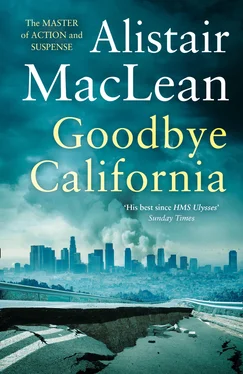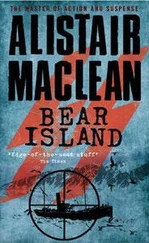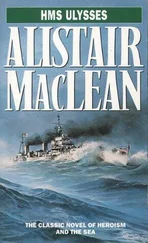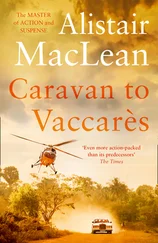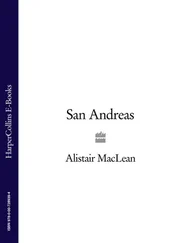GOODBYE CALIFORNIA
Alistair MacLean

Copyright Contents Cover Title Page Copyright Dedication Author’s Preface Chapter One Chapter Two Chapter Three Chapter Four Chapter Five Chapter Six Chapter Seven Chapter Eight Chapter Nine Chapter Ten Chapter Eleven Chapter Twelve Chapter Thirteen About the Author By Alistair MacLean About the Publisher
HarperCollins Publishers Ltd
1 London Bridge Street
London SE1 9GF
www.harpercollins.co.uk
This eBook edition 2009
First published in Great Britain by William Collins Sons & Co. Ltd 1977
Copyright © HarperCollins Publishers 1977
Cover design © HarperCollins Publishers Ltd 2020
Cover photograph © Stephen Mulcahey
Alistair MacLean asserts the moral right to be identified as the author of this work
A catalogue copy of this book is available from the British Library.
This novel is entirely a work of fiction. The names, characters and incidents portrayed in it are the work of the author’s imagination. Any resemblance to actual persons, living or dead, events or localities is entirely coincidental.
All rights reserved under International and Pan-American Copyright Conventions. By payment of the required fees, you have been granted the non-exclusive, non-transferable right to access and read the text of this e-book on screen. No part of this text may be reproduced, transmitted, down-loaded, decompiled, reverse engineered, or stored in or introduced into any information storage and retrieval system, in any form or by any means, whether electronic or mechanical, now known or hereinafter invented, without the express written permission of HarperCollins.
Source ISBN: 9780008337476
Ebook Edition © May 2009 ISBN: 9780007289301
Version: 2020-09-16
Dedication Contents Cover Title Page Copyright Dedication Author’s Preface Chapter One Chapter Two Chapter Three Chapter Four Chapter Five Chapter Six Chapter Seven Chapter Eight Chapter Nine Chapter Ten Chapter Eleven Chapter Twelve Chapter Thirteen About the Author By Alistair MacLean About the Publisher
Gisela
Contents
Cover
Title Page GOODBYE CALIFORNIA Alistair MacLean
Copyright
Dedication
Author’s Preface
Chapter One
Chapter Two
Chapter Three
Chapter Four
Chapter Five
Chapter Six
Chapter Seven
Chapter Eight
Chapter Nine
Chapter Ten
Chapter Eleven
Chapter Twelve
Chapter Thirteen
About the Author
By Alistair MacLean
About the Publisher
It was at twenty seconds to six o’clock on the morning of 9 February 1972 that the earth shook. As such tremors go it could hardly even be called noteworthy; it was certainly no more remarkable than those that afflict the citizens of Tokyo and its surrounding countryside scores of times a year. Pendant lamps oscillated briefly, some precariously balanced objects fell from their shelves, but those were the only discernible effects of the passing of the earth ripple. The aftershock, considerably weaker, came twenty seconds later. It was learnt afterwards that there had been four more aftershocks, but those were of so low a magnitude that they registered only on the seismographs. Altogether a rather inconsequential affair, but memorable for me, at least, inasmuch as it was the first-ever tremor I had experienced: having the ground move beneath your feet provides a distinctly disquieting sensation.
The area where the maximum damage had occurred lay only a few miles to the north and I drove out to see it, but not until the following day – partly because of reports of fissured roads, damaged viaducts and burst water mains but chiefly because the authorities bend an unkindly eye on rubber-neckers whose unwanted presence interferes with the efforts of rescue and medical teams.
The township of Sylmar, which had borne the brunt of the earthquake, lies in the San Fernando Valley in California, some miles north of Los Angeles – in fact, so unconscionably sprawling is that city that it encompasses Sylmar within its boundaries. To the untutored eye the scene in that town appeared to be one of considerable confusion, with wreckers, bulldozers and trucks milling around at apparent random, but this was entirely illusory: all activities were highly organized and under central control. Unlike their more unfortunate brethren in, say, Nicaragua or Guatemala or the Philippines, places sadly accustomed to being side-swiped by much more than their fair share of earthquakes, the Californians are not only prepared for but are highly geared to deal efficiently with the aftermaths of natural disasters: the San Franciscans, for instance, have fifteen hospitals in kit form distributed at various key points around their city in preparation for the next earthquake which is widely and more than a little fearfully regarded as inevitable.
Damage to buildings was widespread but not severe – except in one very localized area. This was, or to a considerable extent had been, the Veterans’ Administration Hospital. Before the earthquake it had consisted of three parallel blocks of buildings. The two outer blocks had remained virtually intact: the central one had collapsed like a house of cards. Destruction was total; no part of it was left standing. Over sixty patients died.
The contrast between this ruin and the virtual immunity of the two sister blocks would have seemed incomprehensible to anyone without some knowledge of the Californian building codes. With some such knowledge it was all too readily understandable. The city of Los Angeles has the misfortune to have its very own private and personal structure fault running under its streets. This is known as the Newport-Inglewood Fault, and when one side of the fault suddenly jerked forward in respect to the other in 1933 it produced the Long Beach earthquake in which a disconcertingly large number of buildings fell down, solely because they had been shoddily built on unreinforced, made-up ground.
This prompted the authorities to introduce a new building code, designed to result in structures as nearly earthquake-proof as possible, a code that is as rigorously enforced as it is rigorous in nature, and it was under the enforcements of this code that the two outer blocks of the Veterans’ Hospital had been built, one in the late 1930s, the other in the late 1940s: the destroyed block had been constructed in the mid-twenties.
Nevertheless, it had been destroyed by an earthquake the epicentre of which had been some eight miles distant to the north-east. But what was important – and significant – about the earthquake that had caused this considerable damage was the factor of its power – or lack of it. The power, or magnitude, of an earthquake is registered on an arbitrarily chosen Richter scale which ranges from zero to twelve. And what is important to bear in mind is that the Richter scale progresses not arithmetically but logarithmically. Thus, a six on the Richter scale is ten times as powerful as a five or a hundred times as powerful as a four. The San Fernando earthquake which levelled this hospital block in Sylmar registered six-point-three on the Richter scale: the one that wreaked havoc on San Francisco in 1906 registered seven-point-nine (according to the recent modifications of the Richter scale). Thus, the earthquake that caused this damage in Sylmar was possessed of only one per cent of the effective power of the San Francisco one. It is a sobering and, to those burdened with an over-active imagination, a fearful reflection.
Читать дальше
